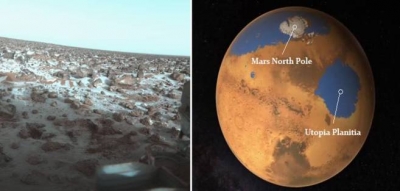
“Utopia,” is a combination of two Greek words meaning “not” and “place.” It was created by Sir Thomas More in 1516 to name a fictional and remote island in his book. Now, the Utopia on Mars may be far, far away. But it is neither an island, nor imaginary! It is an impact crater in Mars’ northern hemisphere, and the flat terrain inside it is called Utopia Planitia.
With an estimated width of almost 3,300 kilometres, the Utopia Planitia is believed to be the largest impact basin found to date on Mars, as well as in our solar system. But that is not its only speciality. Some areas in Utopia Planitia have curiously-shaped shallow depressions, called scallops, which may be clues to the presence of water-ice beneath the surface.
We have also found polygon-shaped fracture patterns on the basin floor, the origins of which continue to puzzle scientists. They may have been formed when the once-hot volcanic surface cooled down, contracted and cracked. Another theory is that loose deposits of dust, soil and small pieces of rock forming the surface material shrunk over time and created these troughs. We can see such polygonal patterns inside certain other Martian impact basins as well. What is even more surprising is that we can also find them here on Earth, in the Arctic regions, where ground becomes frozen!
Picture Credit : Google




